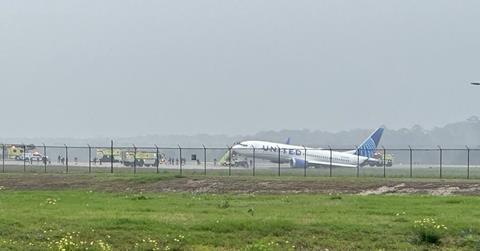The captain of a United Airlines Boeing 737 Max 8 that left the taxiway and suffered a collapsed landing gear after landing in Houston recalled to accident investigators wanting to “expedite their time on the runway”.
A preliminary report on the 8 March incident from the US National Transportation Safety Board (NTSB) discloses that the aicraft’s captain started braking when the 737 was about 1,220m (4,000ft) from the end of the runway. He then attempted to leave the runway to enter the taxiway at a relatively high speed, rolling off the pavement and impacting a concrete structure, collapsing the left main landing gear.
The narrowbody jet came to rest in a grassy area with its left winglet and engine nacelle touching the ground.
”He did not ’slow too much initially’ because the runway appeared dry, he wanted to expedite their time on the runway and because he preferred decelerating gradually for passenger comfort,” the NTSB says.
No injuries were reported among the flight’s 160 passengers and six crew members, all of whom de-planed using stairs.
”We are thankful for the actions of our crew to de-plane all passengers safely,” the airline said at the time of the accident. ”We will work with the NTSB, FAA and Boeing to understand what happened.”

Operating as United flight 2477 from Memphis to Houston, the 737 landed around 08:00 local time on 8 March. The flight path showed heavy thunderstorms in the area.
The captain requested an approach to runway 27 at Houston’s George Bush Intercontinental airport, and asked the first officer to request permission from air traffic control to roll to the end of the runway, which was granted.
”A tower controller approved it and instructed them, ’keep your speed up’,” the NTSB says.
Visibility under the clouds was good on approach, the pilots reported to investigators. The captain recalled that the runway appeared dry, while the first officer said the surface appeared wet.
Shortly after landing, the captain deployed thrust reversers and retracted speed brakes, “which disabled the auto-brakes”, the NTSB says.

The pilot reported applying the aircraft’s brakes about 1,830m from the end of the runway. Flight data reviewed by the NTSB’s Vehicle Recorder Laboratory in Washington DC, showed that manual braking did not begin for another 610m.
“The captain recalled hearing the runway awareness and advisory system alerter indicating 1,000ft of runway distance remaining,” the NTSB says. “He became concerned and began applying more pressure to the brakes.”
As the end of the runway neared, the pilot attempted to turn onto the taxiway “by utilising the steering tiller and rudder pedals while pushing aggressively on the brake pedals”.
The 737 entered the taxiway travelling at a ground speed of 39kt (72km/h).
“During the turn onto the taxiway, he felt the fuselage and rudder/brake pedals begin to shake violently,” the report says. The captain released foot pressure on the pedal and then re-applied it, which made the shaking start again. The aircraft left the taxiway at a speed of 22kt.
The left main landing gear tires impacted a large concrete manhole for lights and utilities. The landing gear “separated from the airplane at the fuse pins near the rear spar as designed to prevent more severe damage to surrounding structures”.
The Max 8 came to rest “on the left engine nacelle, left winglet and the aft fuselage”. Investigators noted “substantial damage” to those areas of the aircraft.
The NSTB’s report notes that the captain is 61 years old and was hired by United in 1987, since accumulating more than 15,000 flight hours in the cockpit of a 737. The first officer is 38 years old and has 1,252h in the 737.
The incident came amid a flurry of headline-grabbing safety incidents that has prompted increased scrutiny from the Federal Aviation Administration (FAA). Late last month, the FAA said it had paused a variety of United’s certification activities and that it was stepping up its presence at the Chicago-headquartered carrier’s facilities in response to its apparent safety struggles.
“The number of safety-related incidents in recent weeks have caused us to pause and evaluate whether there is anything we can and should do differently,” United’s vice-president of corporate safety Sasha Johnson said in a 22 March memo to employees. “Safety is foundational to the success of the airline and we can never take it for granted.”































